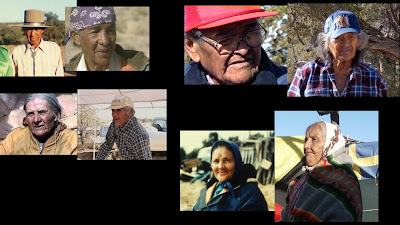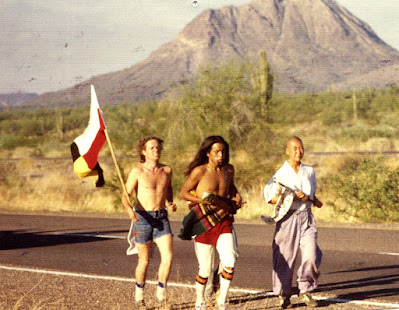Big Mountain Ancient Legacy As You've Never Seen
Saturday, March 1, 2025
Help with Expenses for Travel, Film Screenings & Festival Submissions
Friday, February 28, 2025
Thursday, April 25, 2024
Big Mountain Legacy Film: SYNOPSIS / Re-enactments / A Dream of a Man
Director: Bahe (Naabaahii) Katenay (Keediniihii), October 2023 (75 minute featured documentary)
In the 1970s, D7neh (Navajo) families around Big Mountain were notified that their communities would be uprooted and that they may never see their ancestral homelands ever again. Now 50 years later, less than 20 home sites remain and the once strong resistance leaders like Pauline Whitesinger, Haastin Niiz Begay, John Katenay, and Roberta Blackgoat have all passed on. How should the future remember the legacies of such wise teachers? What gave their community the will to defy U. S. Congressional Legislations that were nothing but anti-Indian which was forcing them to give up hundreds of years of cultural existence?
The Congress of the United States passed Public Law 93-531 in 1974 and it was signed by the President. It is an Executive Order, a declaration to exterminate, a declaration of war. The justification for this law was to “resolve” a supposed “land-dispute” among the Hopis and Dineh, and the lands were divided.
The 2023 Video Documentary:
The original impetus for resisting the federal mandate was the sacredness of the lands, ancestral ties and natural features which were dwelling places of Deities. The elder interviewees knew the future will not be the same way as they had lived and the same childhood experience. The video put aside much of the effective resistance against the most powerful, capitalistic country in the world, instead the video presents stories about their ancestors’ teachings. A D7neh ritual existence which was basically daily living, ceremonies and nutrition. An indigenous atmosphere long before the Europeans’ arrival with its brutal conquest. The video narrowly touches on a 400-year history of cultural survival and maintaining identity. And how that history overlaps with so-called modern America.
One grandmother’s story become an intense chapter, and it is about her direct clan ancestry facing near annihilation as one little girl survives which resulted in re-establishing a Clan at Big Mountain. This story comes from a massacre site with two mass graves. Then stories about decades of intense state of fear and which lead into the US’s late 1800s war policy of random killing, starvation and captivity. The modern times the 1920s and 30s when these story tellers were born, a different state of fear had re-emerged, and then again at their elderhood in the late 1900s. All the stories in this documentary program are messages for the future because, as these elders have predicted, the lands maybe empty of indigenous culture which once thrived for centuries.
The Re-enactment Scenes:
Scenes of re-enactments were originally inspired by the ancestors’ stories being retold. One was that horrible massacre, and that story also gave the will power for the elders to resist the relocation laws.
A couple of implicit scenarios were put into the massacre re-enactments which dips into relevant history.
(For whatever reason hate existed, the Europeans used foes of D7neh, the Comanches as scouts.)
(Facts from archaeology noted that preColumbian MesoAmerica frequent far into northern Arizona.)
Other additional scenes were attempts to give authenticity to the stories about culture and lands impacted by the eviction policies.
A Simple Man’s Dream to Video Document Big Mountain
David Ray McQuade is from West Virginia, an American Scotch Irish. The region where he grew up was in eastern slopes of the great Appalachian Mountains. His time of growing up, based on stories he shared, reminds me of Howard Zinn’s book “A Peoples’ History of the United States.” Mainly about his ancestors’ experience of the harsh times among untamed white society versus, the lords. The era of the Hillybilly survival and their resistance to enslavement in the underground coal mines or being grunts for the wealthy lumber tycoons. Poverty was rampant causing bitter feuds with outside clans. However, most of the Hillybillys were able to survive off nature for food and medicine. By the time David was born his parents were a well-situated American family with having 14 siblings. His dad was a coal mine lower status, site operation supervisor, and they owned a house.
David with a bit of that Old English Irish Scottish accent would tell of his ancestors similar to the following phrases:
“…being called backwards and uneducated... Having your accent ridiculed... growing up in the mountains, you are heir to a legacy... Mountain mothers worked in the fields and were usually the moral compass of the family. Mountain fathers worked all day in the coal mines, built homes without house plans, and could shoe horses. They were the originators of dealing with whatever life threw at them…” - 2021 West Virginia Hillbilly Ramblings
How David (left in the brown t-shirt) found his way among the Díneh (Navajos) at Big Mountain was another tale of this simple man. Before Big Mountain, he had partnered with his elder brother as street vendors by purchasing the old, abandoned Santa Fe, New Mexico post office lot. They imported goods from Mexico and established the original Jackalope Pottery. David also seeks extra opportunities and there was the 1980s uranium mining boom in the western part of the state. Wages were too good, and not many commitments as a single young man except for occasional boozing. He was down and had just suddenly lost his car and rental space. While still being a uranium miner he heard about a protest against uranium mining, so he hitch-hikes to the protest and wanted to learn about uranium. A couple of Big Mountain Díneh elder delegates were in attendance at the protest. David met a couple of white folks who were doing a film documentary about Navajos resisting a forced relocation law. David quit his uranium mine job and along with is dog, Chevis, they volunteered to assist and helped drive the film crew to Big Mountain.
David and Chevis then decided to just herd sheep and help that way since he knew no filming skills, or anything related to that. Off and on for ten years after that he still came back to the same sheep corral and to the same family. He eventually became an adopted son and brother to the family siblings. He returned back to Santa Fe also to his elder brother and help with the growing business. He then hops on to short term jobs with movie companies that came to town. David’s heart was with Big Mountain, the communities that were protecting the ancestral holy lands from the federal, forced-relocation laws and the industrial greed. He then strongly believed that he could help with recording the historical events happening around him. He had already given much company to his adopted Mom and Dad. So, he approached me about getting the latest video recording equipment and begin shooting interviews and Big Mountain life in struggle.
Neither of us knew nothing about recording on professional video equipment. David recorded based on his amateur ideas of framing shots. At that time, I was very much based at Big Mountain, and I took over the recordings. David then suggested we go to another new format and so I did. I went on recording more and kept his dream of video documentary alive.
Help with Expenses for Travel, Film Screenings & Festival Submissions
FUND RAISING for Screening Event Travel, Renting Venues, and Film Festival Submission Fees. https://gofund.me/89de7939 PLEA...

-
Director: Bahe (Naabaahii) Katenay (Keediniihii), October 2023 (75 minute featured documentary) Background: In the 1970s, D7neh (...
-
FUND RAISING for Screening Event Travel, Renting Venues, and Film Festival Submission Fees. https://gofund.me/89de7939 PLEA...
-
Traditional story tellers from Big Mountain who were experiencing the harsh U.S. relocation law had much more information about their exist...














